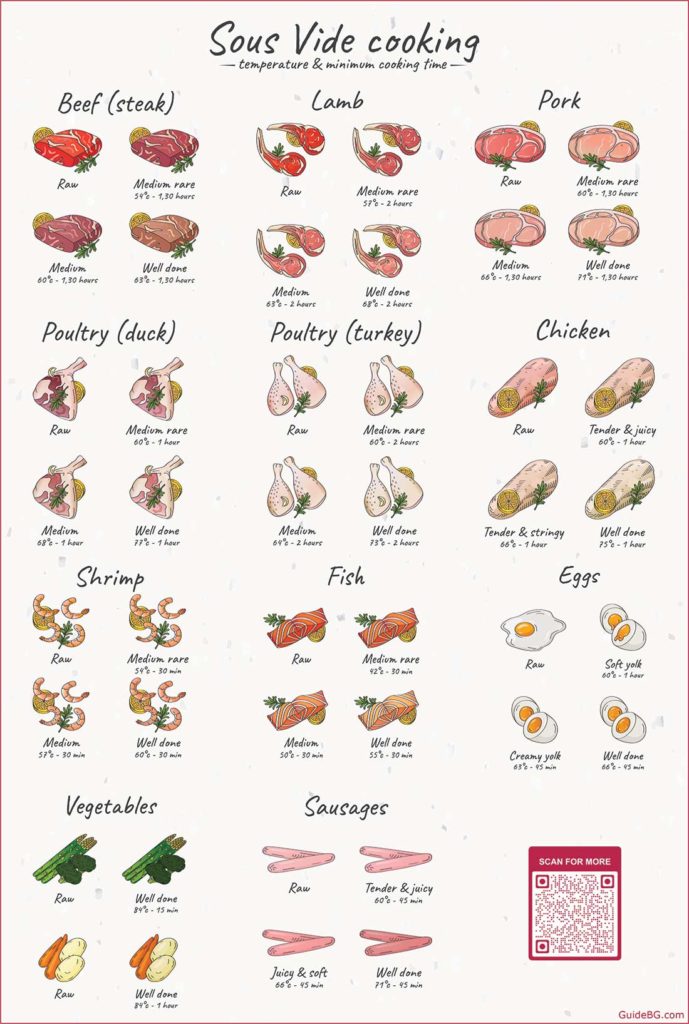Sous vide introduces us to a realm where time transcends mere currency to become the core of culinary excellence. In this method of precision cooking, the difference of just a few minutes can demarcate the boundary between an extraordinary culinary creation and a commonplace dish.
Let us introduce you to the art of Sous Vide – French for “under vacuum” – a cooking technique that combines science with culinary expertise to achieve the perfect plate.
A Brief History of Sous Vide
Though cooking food in a water bath may sound like a modern marvel, Sous Vide’s roots return to the ancient culinary traditions of poaching and simmering. In 1974, French chef Georges Pralus and food scientist Bruno Goussault revolutionized the culinary world by formally introducing the Sous Vide technique. Initially developed to improve the texture and reduce the shrinkage of foie gras, Sous Vide has come to dominate professional kitchens and has now charmed its way into home kitchens.
The Importance of Time and Temperature
The essence lies in its precise control of time and temperature. By sealing food in vacuum-sealed bags and cooking it at a consistent temperature, the technique allows proteins to cook evenly from edge to center. But the perfection Sous Vide promises requires an accurate understanding of cooking times and temperatures.

The Main Attraction: Cooking Times & Temperature
Now, let’s unravel the mystery of perfect cooking times for various proteins. Remember that the following minimum times assume the food reaches the target temperature throughout, so consider additional time for thicker cuts.
Beef
- Medium-Rare: 54°C for 1.5 hours
- Medium: 60°C for 1.5 hours
- Well Done: 63°C for 1.5 hours
Pork
- Medium-Rare: 60°C for 1.5 hours
- Medium: 66°C for 1.5 hours
- Well Done: 71°C for 1.5 hours
Lamb
- Medium-Rare: 57°C for 2 hours
- Medium: 63°C for 2 hours
- Well Done: 78°C for 2 hours
Duck
- Medium-Rare: 60°C for 2 hours
- Medium: 68°C for 2 hours
- Well Done: 77°C for 2 hours
Turkey
- Medium-Rare: 60°C for 2 hours
- Medium: 64°C for 2 hours
- Well Done: 73°C for 2 hours
Chicken
- Tender & Juicy: 60°C for 1 hour
- Tender & Stringy: 66°C for 1 hour
- Well Done: 75°C for 1 hour
Shrimp
- Medium-Rare: 54°C for 30 minutes
- Medium: 57°C for 30 minutes
- Well Done: 60°C for 30 minutes
Fish
- Medium-Rare: 42°C for 30 minutes
- Medium: 50°C for 30 minutes
- Well Done: 55°C for 30 minutes
Eggs
- Soft Yolk: 60°C for 1 hour
- Creamy Yolk: 63°C for 45 minutes
- Well Done: 66°C for 45 minutes
Broccoli, Asparagus
- Well Done: 84°C for 15 minutes
Potatoes, Carrots
Well Done: 84°C for 1 hour
Sausages
- Tender and Juicy: 60°C for 45 minutes
- Juicy and Soft: 66°C for 45 minutes
- Well Done: 71°C for 45 minutes
Converting Celsius to Fahrenheit
Bone or No Bone?
Ah, the eternal debate! In Sous Vide, bone can add flavor and slightly increase the cooking time, particularly for thicker cuts. Bone’s thermal conductivity differs from that of meat, meaning that proteins near the bone may take longer to reach the target temperature. A safe bet is to add an extra 30 minutes for bone-in cuts.
Sous Vide is more than just a cooking technique – it’s an ode to the beauty of chemistry, the precision of physics, and the art of gastronomy. So go forth, culinary virtuosos, and compose your symphonies with the finest ingredients, the best Sous Vide machines, and the treasure of time.
The Sous Vide Revolution
Sous vide is a healthier cooking method for several reasons. First, it locks in nutrients. Traditional cooking methods often result in nutrient loss, but sealing the food in a bag preserves vitamins and minerals. Second, it requires less fat. Unlike frying or sautéing, sous vide cooking doesn’t need extra oil or butter, significantly reducing unhealthy fats.
Pre-cooking Perfection and Meal Prep Made Easy
The technique excels at pre-cooking food. Bringing ingredients to a precise temperature ensures food safety and eases future meal preparations. Once pre-cooked, dishes can be quickly finished by searing, grilling, or broiling, adding texture and flavor without much effort – for example, a Dual-Textured Sous Vide and Flour-Crusted Deep-Fried Chicken.
Transitioning from sous vide to final preparation is seamless. This method ensures optimal flavor and maintains food’s nutritional integrity. In short, sous vide revolutionizes cooking, making meals healthier and more delicious with every bite.


